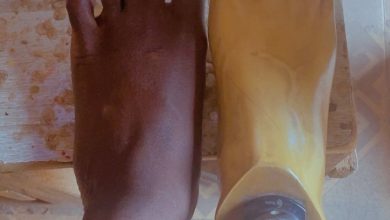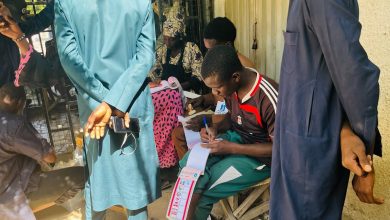COVID-19: The War Room In Nigerian Newsrooms

Asides healthcare workers who are known to be on the frontline in the war against COVID-19, the media constitute a set of warriors in the struggle albeit unsung.
Globally, the media have followed every event on the COVID-19 pandemic, sometimes creating fear but generally raising hope that the pandemic does not mean the end for humanity.
In Nigeria like the rest of the world, the media have not only been the purveyors of information but creators of content meant to encourage the people on ways to survive man’s biggest challenge in modern times ㅡ COVID-19.
HumAngle has monitored 13 major television stations and online newspapers since the outbreak of COVID-19 in the country and found that they have been innovative in their messaging styles.
The stations have created a synergy disseminating official government information on the disease outbreak, especially in covering daily updates by the Presidential Task Force on COVID-19.
Daily, the stations broadcast news, special reports, interviews, and analyses and features to educate the public and engage them with messages of hope, particularly as they are at home because of the lockdown.
Some use their regular programmes to focus on the pandemic. Such programmes include Sunrise Daily and Politics Today on Channels TV; and Road Matters on Nigerian Television Authority (NTA) network.
For example, through interviews and talk shows, Channels TV has addressed various issues, including how physically challenged Nigerians are coping with the disease outbreak, managing mental health during the lockdown, and the alleged link between 5G technology and coronavirus.
The NTA on its part brings senior government officials to its programmes and interviews them about steps that the government is adopting to check the spread of the disease.
Some online platforms such as TheCable, the International Centre for Investigative Reporting (ICIR), Premium Times, Punch, The Guardian, and Daily Trust, have all dedicated spaces on their websites to information and reports on COVID-19.
The publications have also adopted various forms of modern communication, including video reports, infographics, and tweetchats to reach their audiences.
Music as a way into people’s hearts
Channels TV uses music as a tool of public enlightenment and has severally aired “We Go Win (Corona)”, an original song from popular Nigerian musician Cobhams Asuquo.
“No shaking hands with your neighbour. Blow them a kiss from afar. Use soap and water to wage war. Let’s show this thing who we are,” Asuquo admonishes in the song. “Wash your hands, love each other, we go win o,” the song says.
The station also airs “Kanayo”, a song recently released by Nigerian singer, Flavour, which has lyrics that are relevant “at a time when Nigeria and the entire global community are taking time to reflect and ask God for grace, mercy and overall good health during the pandemic”.
Similarly, Ogun State Television (OGTV) has constantly aired a two-minute video partly recorded in Yoruba and featuring music and dance. The attention-grabbing clip sensitises people to the importance of social distancing, handwashing, and generally staying safe.
Visualising the data
Some news organisations have also evolved ways of summarising information and sharing such using infographics.
TheCable, for example, regularly releases infographics breaking down figures from the Nigerian Centre for Disease Control (NCDC) in very attractive ways.
Other designs by the platform educate readers on how they can get infected, things they can do to improve their chances of survival, and measures the NCDC wants various groups and institutions to adopt to curb the spread of the virus.
DailyTrust and HumAngle have also adopted similar strategies.
Every evening, HumanAngle extracts data on Africa in respect of the infection and shares it as infographics.
Another package is the publication’s COVID-19 National Emergency Map and Needs Delivery Scheme that provides information on each state detailing the number and location of available healthcare facilities and helplines for the citizens.
A unique feature of ICIR’s presentation is its use of an interactive dashboard, designed using Microsoft Power BI.
This provides all the fundamental figures about the disease infection locally and globally, drawing from updates provided by the World Health Organization (WHO) and Worldometres.
The dashboard also highlights information on preventive measures prescribed by WHO.
Africa Independent Television (AIT) on its part presents daily updates on the disease in Nigeria with a breakdown of the states using maps.
Guidance through moving pictures
Africa Independent Television (AIT) recorded a one and a half-minute video clip to educate viewers on the symptoms of the disease, its heavy casualty figures, and how people can reduce the spread of the virus through hand-washing, avoiding touching the face, not sharing personal items, and avoiding crowded places.
NTA also airs a two-minute video that includes cartoon illustrations to educate Nigerians on how coronavirus spreads and advises them to adhere to instructions from health authorities.
Apart from the television stations, some online news platforms such as HumAngle, The Guardian and Punch, also use videos to reach their audiences.
Video stories are a particularly strong aspect of Punch’s reports and many of them amplify the voices of ordinary Nigerians who are facing economic hardship due to the pandemic.
What to do about misinformation?
Dubawa, Premium Times’ independent fact-checking group, has especially published a number of reports repudiating misinformation being circulated through the social media.
TheCable has similarly released several well-researched reports to debunk widespread misinformation about COVID-19. And the ICIR has so far published no fewer than nine fact-checks, with key attention paid to claims about unconfirmed treatments for the disease.
Explainers, editorials, investigations
Aside from regular news reporting and publication of opinion pieces, TheCable online newspaper has released articles to explain issues such as the lockdown order and the 5G controversy.
Premium Times reporters have written a number of investigative stories and special reports about the crisis including How Nigerian Security Operatives Killed Five Prison Inmates During Riot; Coronavirus: Nigerian Tertiary Institutions Not Equipped For Distance Learning; and Coronavirus: Nigeria Has 350 ICU Beds For 200 Million People.
Reports from HumAngle have also mostly taken the form of investigation and feature stories. It combines these with regular news reports about the pandemic.
Its “A Day in the Life” series zooms in on how the pandemic is affecting specific groups of people, especially vulnerable Nigerians.
Some of the reports look at how COVID-19 affects the ordinary person in the street. Such individuals include clobbers, domestic servants and taxi drivers who have lost their means of livelihood because of the crisis.
Alongside its opinion and feature sections, Daily Trust has also written several editorials on the challenges Nigeria is facing and what solutions should be embraced.
In an editorial, “COVID-19 and dearth of ventilators”, published on April 7, for example, the newspaper decried Nigeria’s poor preparedness for health emeringencies.
It recommended that research institutions, government agencies and private sector groups should collaborate to manufacture critical medical tools as part of a coordinated development plan to deal with emergencies.
More than just the news have changed
A look at the works of various media groups immediately reveals how much they have adapted their storytelling to become more effective during the pandemic. But there are invisible changes as well, especially in how they operate.
Though journalism is classified as an essential service, most reporters are currently working remotely to reduce the spread of coronavirus — a radical change from the work pattern many of them are used to.
Ajibola Amzat, Editor at the ICIR, told HumAngle that it was easy for the Centre to readjust to the times partly because of its young workforce who are not technology-shy.
Employees now conduct meetings on Skype, Zoom, and WhatsApp for smaller groups.
He advised other media houses to look in the same direction because news writing has to continue regardless of the lockdown and “our job is even more important now than before”.
“If you still want to continue doing your job and you want to be relevant as a journalist, it is very important you learn how to use those tools,” he added.
Giving his assessment, the Executive Director of Media Career Development Network, Lekan Otufodunrin, said local newsrooms are doing well but there is a lot of room for improvement.
More focus should be placed on community, human-angle reporting; breaking down hard-to-understand expressions that are in common use; shedding light on global best practices in tackling the pandemic; giving support and relief materials; as well as providing useful information about where people can get help.
“We need to review how we operate and think of how we can really respond beyond just pushing out information,” Otufodunrin said.
Support Our Journalism
There are millions of ordinary people affected by conflict in Africa whose stories are missing in the mainstream media. HumAngle is determined to tell those challenging and under-reported stories, hoping that the people impacted by these conflicts will find the safety and security they deserve.
To ensure that we continue to provide public service coverage, we have a small favour to ask you. We want you to be part of our journalistic endeavour by contributing a token to us.
Your donation will further promote a robust, free, and independent media.
Donate HereStay Closer To The Stories That Matter




